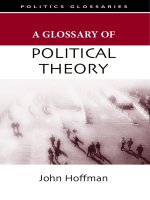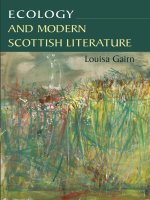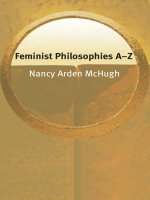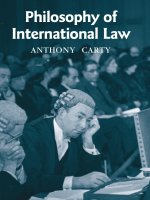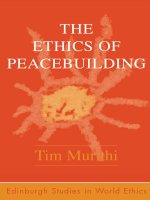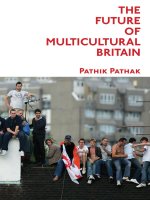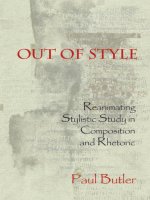edinburgh university press blasphemies of thomas aikenhead boundaries of belief on the eve of the enlightenment nov 2008
Bạn đang xem bản rút gọn của tài liệu. Xem và tải ngay bản đầy đủ của tài liệu tại đây (1.02 MB, 193 trang )
The Blasphemies
of Thomas Aikenhead
The Blasphemies
of Thomas Aikenhead
Boundaries of Belief on the Eve of the Enlightenment
Michael F. Graham
Edinburgh University Press
For my mentors:
H. C. E. Midelfort
and the late Martin J. Havran
© Michael F. Graham, 2008
Edinburgh University Press Ltd
22 George Square, Edinburgh
Typeset in Sabon by
Carnegie Book Production, Lancaster, and
printed and bound in Great Britain by
Biddles Ltd, King’s Lynn, Norfolk
A CIP record for this book is available from the British Library
ISBN 978 0 7486 3426 2 (hardback)
The right of Michael F. Graham to be
identified as author of this work
has been asserted in accordance with
the Copyright, Designs and Patents Act 1988.
Contents
Abbreviations vii
A Note on the Text viii
Acknowledgements ix
Introduction 1
1 Edinburgh and Scotland in the 1690s 10
1.1 The Capital City 10
1.2 The Legacy of the Covenants 17
1.3 Edinburgh and the Changes of 1688–90 25
2 The Politics of Blasphemy 33
2.1 ‘Profaneness’ and Blasphemy 35
2.2 The Parliament of 1695 37
2.3 Political Changes and the General Assembly of 1695–6 43
3 ‘So unnaturall a seasone’: The Dreadful Year 1696 53
3.1 Famine, the French, Fear and Fire 54
3.2 Edinburgh’s Deism Scare 59
3.3 Dangerous Books and the War of Ideas 65
3.4 The Accusation of Thomas Aikenhead 72
4 The Making of a Blasphemer 79
4.1 Spiritual Crises and the Calvinist Mind 79
4.2 Who was Thomas Aikenhead? 83
4.3 Edinburgh’s Town College and the Education
of Thomas Aikenhead 87
4.4 The Attack by Mungo Craig 92
5 Trial and Execution 100
5.1 The Officials and the Prosecution 100
5.2 The Defence 104
5.3 The Witnesses 107
5.4 The Jury and the Verdict 111
5.5 Seeking Mercy 113
5.6 Last Words 117
5.7 Death and Remorse 121
vi the b las phemies of th omas aike nhe ad
6 The Aftermath: Public Opinion in Scotland and England 126
6.1 The Defence of Mungo Craig 126
6.2 More Blasphemy and the Revival of the Witch-Hunt 128
6.3 ‘A Noise’ in England 134
6.4 The English Blasphemy Act 143
6.5 Aikenhead Remembered 147
Conclusion 155
Bibliography of Works Cited 163
Index 175
Abbreviations
APS Acts of the Parliaments of Scotland, 1124–1707, 12 vols
(London: HMSO, 1814–75)
BL British Library, London
ECA Edinburgh City Archives
EUL Edinburgh University Library
Fasti Hew Scott (ed.), Fasti Ecclesiae Scoticanae, 9 vols
(Edinburgh: Oliver & Boyd, 1915–51)
HMC Historical Manuscripts Commission
Home Diary Helen Kelsall and Keith Kelsall (eds), An Album of
Scottish Families 1694–96, Being the First Installment of
George Home’s Diary (Aberdeen: Aberdeen University
Press, 1990)
MS Manuscript
NAS National Archives of Scotland, Register House, Edinburgh
(main location)
NLS National Library of Scotland, Edinburgh
NRH New Register House
OPR Old Parish Records
SHS Scottish History Society
State Trials William Cobbett and T. B. Howell (eds), A Complete
Collection of State Trials, 34 vols (London: Hansard,
1809–26)
WRH West Register House (auxiliary location of the NAS,
Edinburgh)
A Note on the Text
In the 1690s Scotland and England had not yet adopted the Gregorian
Calendar, which had been introduced in Catholic Europe in 1582, but was
slow to win acceptance in Protestant countries and in Russia. As a result,
dates in Britain were eleven days off those of most of continental Europe.
But since the bulk of the action in this book took place in Britain, I have
given dates according to the Julian Calendar, which still prevailed there,
and would for another half-century. Nevertheless I have reckoned all years
as beginning on 1 January, an innovation that was still not universal, but
was coming to be the norm. On the rare occasions when money enters into
this story, readers might find it helpful to know that one pound sterling
was worth twelve pounds Scots. Because I like to let the past speak for
itself, I have retained original spelling, capitalisation and italics when
quoting from original sources, but have inserted bracketed material here
and there to help the reader make sense of what is being quoted. While
scholars often do not list publishers of books from the hand-press era
(up to 1800) I have chosen to do so in the notes and bibliography in cases
where the publisher could be determined, sacrificing consistency on the
altar of increased information. For example, one of the jurors who decided
Thomas Aikenhead’s fate was himself a publisher and bookseller; readers
might want to keep track of such details.
Acknowledgements
Despite the sad fate of its main protagonist, the research and writing of
this book have been a great pleasure; perhaps the time it took to produce
it can be taken as a measure of how much the author was enjoying himself.
Among the things that made it so enjoyable were the kind assistance and
sociability of many colleagues, and the helpful cooperation and generosity
of several institutions. The book grew out of a paper delivered at the
Sixteenth Century Studies Conference a decade ago, in which I sought to
suggest distinctions between ‘sin’ and ‘crime’ in early modern Scotland.
The Aikenhead case loomed large in that because of the severe response
of the Scottish state to his ‘sin’. The commentator for that panel was
Benjamin Kaplan, and his perceptive comments steered me off on the
tangent that became this book. The project received generous financial
support from the Sally A. Miller Humanities Center and the Faculty
Research Committee at the University of Akron, as well as the Reformation
Studies Institute at the University of St Andrews, where I was fortunate
to spend the first half of 2003 as the James Cameron Faculty Fellow. I
would like to extend particular thanks to Professor Andrew Pettegree,
who was then director of the institute, and his wife, Jane, for their help
and hospitality in St Andrews. The community of scholars at St Andrews
is a lively and supportive group, and I should also thank Dr Bridget Heal,
Andrew’s successor as institute director, Dr Roger Mason of the Scottish
History Department there, and Robert Crawford of the School of English,
who not only took an interest in my project, but has given kind permission
to use a wee bit of his poem ‘Burns Ayont Auld Reekie’ as an epigraph.
Ted Cowan invited me to Glasgow to give a talk in May 2003, and I
am grateful to him and members of the Scottish History Department at
the University of Glasgow, aided and abetted by Alexander Broadie, for
their helpful comments on part of what was to become Chapter 6 of this
book. Michael Lynch welcomed me into the circle of Scottish historians in
Edinburgh when I was a complete neophyte at the beginning of the 1990s,
and he was generous with his time in discussing this project also, as were
his colleagues Julian Goodare and Jenny Wormald. Among the select group
that pursues the Scottish past from the New World, Elizabeth Ewan, David
x the b las phemies of th omas aike nhe ad
Mullan and Daniel Szechi have my gratitude for their assistance, although
the last of them has crossed over to the Old World again.
Here in Akron, my colleagues Michael Levin and Constance Bouchard
carefully read over my manuscript and in the process made it better, even
if I have been stubborn in not taking all their advice. I am also grateful to
Walter Hixson, interim chair of the Department of History, who gave me a
reduced teaching load in the autumn of 2007 to enable me to complete the
writing of this book. Wade Wilcox, administrative assistant, and Nicolette
Silvestro, student assistant, also provided technical help at critical times.
I was fortunate to spend much of the summer of 2007 in Oxford and
Antwerp in the company of the ‘Reformation of the Book, 1450–1700’
seminar, supported by the National Endowment for the Humanities and
directed by John King and James Bracken of the Ohio State University.
I thank them and all the ‘seminarians’ for the synergy produced by our
various projects together, all centred on the first three centuries of print,
which certainly improved this book. Special additional thanks are due to
the Ohio State University Libraries and James Bracken, in his capacity
as their assistant director, for supplying me with a reproduction of the
drawing of the tollbooth, which comes out of the library collection. It is
used in this book with their kind permission, as well as the permission
of the Book of the Old Edinburgh Club, in which it originally appeared.
The maps that appear in the introduction and Chapter 1 were expertly
prepared by Ann Donkin, archaeogeophysical surveyor in the Department
of Classical Studies, Anthropology and Archaeology at the University of
Akron.
Historians could not reconstruct the past without the help of the
archivists and librarians who are its keepers. In Edinburgh, the staffs of
the National Archives of Scotland, the National Library of Scotland, the
Edinburgh University Library and the Edinburgh City Archives were unfail-
ingly helpful, providing access and their expert knowledge to scholars (such
as this one) free of charge, thus exemplifying a fundamental value of open
enquiry that is under attack in some quarters. I owe similar thanks to
the staff of the British Library in London. The librarians at the Bodleian
Library in Oxford were also patient and helpful, and I could not have got
much done on this project when in Ohio were it not for the staff of Bierce
Library at the University of Akron, and the OhioLink network, for which
all researchers in the state should be grateful.
I also thank Esmé Watson, my editor at Edinburgh University Press, for
her interest in taking on this book, and for suffering patiently its author’s
questions and concerns. It seemed appropriate to me that Aikenhead’s
story be told through the press that graces the university he attended.
But nobody bears the burdens of authorship as much as those who live
with authors, so my deepest thanks go to Elizabeth Armstrong, who not
only shares my life but is an excellent editor, and has cleared up many
ambiguities and infelicities in the text of this book. Our children David,
Katharine and Sean have been hearing about Thomas Aikenhead for a long
time. Thanks to him, they got to go to school in Scotland for a term; I
hope this book will remind them of our collective adventures, and repay
their patience with an occasionally distracted father.
Acknowledgements xi
Introduction
Daft rammishes an gowks
Witter oan an oan as if thi nemm wiz Tam
Aikenheid, no Tam o Shantir, as if aw
Wir ramskerie leid wiz jist ane dour stane baa.
Muck-wreistlin Scoatlaun, durt’s yir histoarie,
Naishunlet aye oabsessed wi kickin baas –
Yi scum yir makars oar cute-gralloch thaim – Ach!
(Robert Crawford, ‘Burns Ayont Auld Reekie’
1
)
Let us start with a hanging, to focus the mind. Early in the afternoon of
Friday, 8 January 1697, Thomas Aikenhead, a twenty-year-old sometime
student at the town college (now University) of Edinburgh, was taken out
of the condemned prisoners’ cell in Edinburgh’s tolbooth to be hanged for
blasphemy, having been convicted of that crime about two weeks earlier.
Coming out of the tolbooth, he paused near the mercat cross and handed
over two documents (possibly reading from them) – one an intellectual
autobiography that was both a justification for his religious scepticism
and an expression of regret, and the other a covering letter addressed to
his ‘friends’, pleading his true remorse. He then asked the two ministers
attending him, James Webster of the Tolbooth parish, where Aikenhead
had offered repentance the previous Sunday, and George Meldrum of the
Tron parish, where he had probably lived before taking up residence in
the tolbooth, to pray for him, which they did, publicly. Following that,
Aikenhead offered prayers himself, specifically invoking the Trinity, one of
the aspects of Christian doctrine that he had been accused of ridiculing.
Then, clutching a Bible, Aikenhead began what must have been a chilly
and terrifying walk to the scaffold. At least it was mostly downhill.
A public execution such as this one was in large measure a religious
ritual – hence the prayers, the symbolic use of the Bible and the plentiful
opportunities for the condemned to warn others to avoid his miserable
2 the b las phemies of th omas aike nhe ad
fate and assure them that he accepted the justice of what was about to
happen. But the act itself was the result of a process controlled by the
state, and its agents were present in force. Aikenhead was flanked by two
columns of troops, which suggests that the authorities feared some kind
of disturbance. From the mercat cross they filed down the High Street,
past the Tron Kirk, in front of which Aikenhead had uttered one of his
alleged blasphemies on a cool evening the previous August. After passing
through the Netherbow Port, which led into the top of the Canongate (a
neighbourhood recently devastated by a severe fire), they turned left, and
headed down Leith Wynd, passing between Trinity Hospital and Kirk on
the left, and the Correction House and the Paul’s Work orphanage on the
right, with Calton Hill looming behind. Past the hill they turned to the
north-east, and marched down the road towards the port of Leith, roughly
following the Leith Walk of today. At this point they would have left the
built-up area of Edinburgh. At the formal boundary between Edinburgh
and Leith (not terribly significant any more, since Edinburgh had gained
jurisdiction over Leith more than a hundred years earlier), they stopped and
turned left. Here was the Gallowlee, the execution site reserved for those
guilty of the most heinous crimes. For common thieves, murderers and
even many witches, the Grassmarket below Edinburgh Castle would do.
But this execution was far from typical. On the contrary, it was a smokeless
auto-de-fé aimed at placating an obviously angry God, invoking new laws
against blasphemy that would never be used with such force again. At
the Gallowlee, still holding the Bible, Aikenhead seemed ‘surprised &
terrified for death’, according to the devout Sir John Clerk of Penicuik,
an eyewitness who certainly approved of the proceedings. Aikenhead again
confessed his crimes and sang part of the Fifty-First Psalm:
Have mercy on me, O God, according to thy steadfast love;
according to thy abundant mercy blot out my transgressions.
Wash me thoroughly from my iniquity, and cleanse me from my
sin!
For I know my transgressions and my sin is ever before me.
Against thee, thee only have I sinned, and done that which is evil
in thy sight,
so that thou art justified in thy sentence and blameless in thy
judgment …
The doomed man then prayed some more ‘but w[i]t[h] great disorder (as
is said) of speech’, giving ‘but litle evidence of his sincere repentance’,
Clerk of Penicuik reported. A hood was placed upon him, and he was
hanged. Those hanged rarely died instantly, so onlookers probably would
have watched him shudder for several minutes as he twisted in the chilly
January breeze and gathering darkness, fists clenched, nose and mouth
oozing bloody mucus, gradually suffocating. The moment of death was
often marked by the appearance of stains as the victim’s bladder and
bowels released their contents.
2
Later, Aikenhead’s corpse was buried at
the foot of the gallows.
Clerk of Penicuik, like many of those present, clearly got the message
intended by the authorities. Indeed, he was one of them, having represented
the shire of Edinburgh at the parliament that had passed a new blasphemy
statute in 1695.
3
As he wrote in his diary: ‘ye sanctified use of this be given
to me and all p[ersons] for [Christ’s] sake O L[ord] my heart atheism &
unbeliefe be rooted out O L[ord] in my soul for thy [Christ’s] sake.’ He
searched for signs of Aikenhead’s true repentance, because such remorse
was an essential element in execution as a public performance. Some
onlookers thought Aikenhead was truly penitent, while others did not, and
this would be an ongoing subject of debate in the aftermath.
4
There was a
third group that did not believe the hanging should have taken place at all,
Figure I.1 Thomas Aikenhead’s final journey.
(Map prepared by Ann Donkin.)
Introduction 3
4 the b las phemies of th omas aike nhe ad
whether or not the victim was remorseful; this group is hardest to identify
at the hanging itself, and had good reasons to keep silent. But its presence
is suggested by the large guard and the report of one contemporary that
Aikenhead had received encouragement from people who gathered under
his cell window in the tolbooth at night.
5
Aikenhead’s execution was the
final scene in a drama that had been building for more than a year, and
would be a defining moment in the providential story of Scotland as
God’s Covenanted Kingdom. It would create embarrassment abroad and a
mixture of righteous justification and soul-searching at home. Not surpris-
ingly, historians have been more unanimous in their verdict.
Thomas Babington Macaulay probably echoed the feelings of many
of his nineteenth-century Anglo-American contemporaries when he
condemned the execution as a vestige of Scottish superstition and intol-
erance in his History of England (1849–55): ‘the preachers who were the
boy’s murderers crowded round him at the gallows, and, while he was strug-
gling in the last agony, insulted Heaven with prayers more blasphemous
than anything he ever uttered.’
6
More recent scholars, while displaying less
anti-clerical fervour and less poetic licence, have nevertheless placed blame
solely on the shoulders of the ministers, interpreting the Aikenhead case as
a sign of a Presbyterian Kirk determined to assert its coercive authority.
7
The case receives passing mention in surveys of Scottish history or British
heterodoxy during the period, sometimes with mistakes as to the year,
location or method of execution, or the victim’s name.
8
Aikenhead has even
inspired poetry and a forgotten historical novel.
9
But it took until 1992 for
any historian in the modern era to offer a fresh analysis of the evidence in
the case. Michael Hunter, in an essay titled ‘ “Aikenhead the Atheist”: The
Context and Consequences of Articulate Irreligion in the Late Seventeenth
Century’, cited some previously unknown evidence, particularly a long
letter from the minister Robert Wylie, to offer an intellectual history of
Aikenhead’s crimes, seeing him as a serious (if unrefined) critic of conven-
tional Christianity who could have gathered some of his ideas from books
in circulation at the time, cobbling them together into his own peculiarly
heterodox cosmology.
10
Unfortunately, Hunter, concerned more with the history of ideas than
social and political factors, did not really consider the context of the case:
the bustling capital of a kingdom in growing economic and political crisis,
governed by a regime struggling to keep alive a revolutionary legacy in
the face of conflicting currents, many of them coming from England, its
southern neighbour and more powerful partner in the union of crowns. A
government that bases its authority on a particular ideology and that feels
itself threatened will often prosecute an individual dissident to demonstrate
that it still holds power (witness the death sentence for blasphemy imposed
in 2002 by Iranian judges against the historian Hashem Aghajari, for his
suggestion that the Qur’a¯n is subject to modern interpretation, a sentence
later commuted to a prison term after widespread protests). This is not
to deny Macaulay’s claim that the ministers were critical players in this
story, or Hunter’s assertion of the importance of Aikenhead’s ideas and
their genealogy. But neither Macaulay nor Hunter really explained why
Scotland’s magistrates, who alone held the power to impose physical
punishment, chose to use it in such a dramatic way. This question is further
highlighted by the fact that not only was Thomas Aikenhead the last
person executed in Britain for the crime of blasphemy; he was probably
the first so treated in Scotland, a kingdom that hardly had a reputation for
toleration. Two recent studies of the decline of witch-hunting also make
passing reference to Aikenhead’s case, exploring the conjunction, first
noted among historians by Macaulay, between it and one of the last revivals
of the Scottish witch-hunt; like the witches of Renfrewshire, Aikenhead
was an ‘enemy of God’, albeit of a less traditional type.
11
The Aikenhead case seems ripe for the microhistorical approach
pioneered by Natalie Zemon Davis and Carlo Ginzburg, but thus far little
used in the field of Scottish history.
12
As with the peasant imposter Arnauld
du Tilh and the eclectically-minded miller Mennochio, Aikenhead’s travails
left a paper trail in the courts, and the trial records, many of which were
published early in the nineteenth century, provide the central documen-
tation for the story.
13
But, while the trial (and execution) may comprise the
main drama here, they make little sense if divorced from their historical
context. A full exploration of that context is critical for any microhistorical
study of Thomas Aikenhead. It will help us comprehend what to modern
eyes seems incomprehensible – the imposition of capital punishment for a
crime of belief at the end of the era of confessionalisation, even after the
alleged British watershed of 1688–9, and on the eve of the Enlightenment
– and in so doing will help to elucidate the historical relationship between
‘sin’ and ‘crime’. Certainly, witches were still occasionally burned at the
stake in late seventeenth-century Scotland, and would be, in sporadic
revivals of the witch-hunt, for three more decades.
14
But witchcraft accusa-
tions by this time were always founded on maleficia – alleged evil deeds
towards others. Aikenhead’s crime, in contrast, had no human victim.
Further, while denunciations of religious dissent, coupled with threats
of severe punishments for dissenters, had been standard Scottish (and
indeed west European) fare for centuries, few such threats had actually
been carried out in Scotland. In fact, the 136 years since the Reformation
Parliament of 1560, for all their politico-religious upheaval, had been
Introduction 5
6 the b las phemies of th omas aike nhe ad
remarkably free of martyrs for belief (or unbelief). Many had died for
causes related to religion, particularly in the period of highly politicised
covenants after 1638, but these victims had found themselves on the wrong
side of political struggles, and were more likely to meet their ends on the
battlefield than the scaffold. There was no such obviously political element
in Aikenhead’s demise.
Then why did the authorities choose to make such a dramatic example
out of one relatively obscure student? There is no single answer to
this question, but a series of historical convergences made a victim like
Aikenhead seem almost necessary in 1696–7. This study will piece those
convergences together, reconstructing the atmosphere of crisis and uncer-
tainty in which critical decisions were made. But almost as significant as
the case itself was its afterlife. It was covered in London newspapers and
debated – both inside and outside Scottish and English political and clerical
circles – in its aftermath, casting a shadow into the early decades of the
eighteenth century. Thus it provides an Anglo-Scottish chapter in the early
history of ‘public opinion’ as well. And, finally, we must not forget that
the case arose in a city that would become one of the leading centres of
the Enlightenment. Many of the statements allegedly uttered by Aikenhead
– about the origins of Scripture, the historicity of figures like Moses and
Jesus, and the logical consistency of the idea of the Trinity – while not
exactly mainstream by 1750, would not at that later date have earned a
Scottish critic anything worse than public ridicule or the denial of profes-
sional advancement. But the Aikenhead case was born in the initial collision
between Covenanted Presbyterianism and the countercurrents of deism,
biblical criticism and religious scepticism. As the historian of philosophy
Noel Malcolm has recently put it: ‘Among the faithless, Aikenhead’s joke
about “Ezra’s fables” had become, so to speak, an article of faith’ by 1750.
David Hume got to die in his bed, while his devout friends, such as the
Edinburgh minister Hugh Blair, worried about his eternal fate.
15
Thomas
Aikenhead had a much less comfortable send-off.
NOTES
1. Robert Crawford and W. N. Herbert, Sharawaggi: Poems in Scots
(Edinburgh: Polygon, 1990), p. 50.
2. This account of Aikenhead’s execution is based on National Archives of
Scotland (hereafter NAS) MS GD18/2092/1, Sir John Clerk of Penicuik’s
Spiritual Journal, entry for 8 January 1697; The Post Man, 265 (16
January 1697); Robert Paul (ed.), ‘The Diary of George Turnbull,
Minister of Alloa and Tyningham, 1657–1704’, Scottish History Society
Miscellany, 1 (Edinburgh: Scottish History Society, 1893), pp. 295– 445,
at p. 370. I am grateful to Professor Daniel Szechi for pointing me in the
direction of Clerk’s spiritual journal. Geographical details come from
The Early Views and Maps of Edinburgh, 1544–1852 (Edinburgh: Royal
Scottish Geographical Society, 1919), maps 1 and 2; Helen Dingwall,
Late Seventeenth-Century Edinburgh: A Demographic Study (Aldershot:
Scholar, 1994), pp. 14 –15. Aikenhead’s final two letters are in William
Cobbett and T. B. Howell (eds), A Complete Collection of State Trials, 34
vols (London: Hansard, 1809–26) (hereafter State Trials), xiii, pp. 930– 4.
This translation of the first two stanzas of the psalm comes from The
New Oxford Annotated Bible (New York: Oxford University Press,
1973), p. 694. For the physiology of hanging, see V. A. C. Gatrell, The
Hanging Tree: Execution and the English People, 1770–1868 (Oxford:
Oxford University Press, 1994), pp. 45–50.
3. Acts of the Parliaments of Scotland, 1124–1707, 12 vols (hereafter APS)
(London: HMSO, 1814–75), ix, p. 347.
4. Claiming he was truly repentant: NAS MS GD 406/1/4204 (David
Crawford to the Earl of Arran, 9 January 1697); NLS MS Wodrow
Quarto XXX, fos 244r–245r (Alexander Findlater to Robert Wylie, 8
January 1697); Paul (ed.), ‘Diary of George Turnbull’, p. 370; The Post
Boy, 266 (16 January 1697); The Flying Post, 267 (26 January 1697);
William Lorimer, Two Discourses: The One Setting forth The True and
only way of Attaining Salvation. The Other shewing why and How all
ought to Reverence Jesus Christ, the Son of God and Saviour of Men
(London: John Lawrence, 1713), p. vi. Claiming he was not: Mungo
Craig, A Lye Is No Scandal, Or a Vindication of Mr Mungo Craig from
a Ridiculous Calumny Cast Upon Him by T. A. Who was Executed for
Apostacy at Edinburgh, the 8 of January, 1697 (Edinburgh[?], 1697),
p. 9; Thomas Halyburton, Natural Religion Insufficient and Reveal’d
Necessary to Man’s Happiness In His Present State (Edinburgh: Heirs
of Andrew Anderson, 1714), p. 123.
5. Lorimer, Two Discourses, p. v.
6. Thomas Babington Macaulay, The History of England from the
Accession of James II, 3 vols [1849–55] (London: J. M. Dent, 1905), iii,
p. 510.
7. James Cameron, ‘Theological Controversy: A Factor in the Origins of
the Scottish Enlightenment’, in R. H. Campbell and Andrew S. Skinner
(eds), The Origins and Nature of the Scottish Enlightenment (Edinburgh:
John Donald, 1982), pp. 116–30, at p. 117; James Cameron, ‘Scottish
Calvinism and the Principle of Intolerance’, in B. A. Gerrish and Robert
Benedetto (eds), Reformatio Perennis (Pittsburgh: Pickwick Press, 1981),
pp. 113–28, at pp. 123–5; Andrew Drummond and James Bulloch, The
Scottish Church 1688–1843: The Age of the Moderates (Edinburgh:
Saint Andrew Press, 1973), pp. 13–15; George Davie, The Scottish
Enlightenment (London: Historical Association, 1981), pp. 9–10; Arthur
Introduction 7
8 the b las phemies of th omas aike nhe ad
Herman, The Scottish Enlightenment: The Scots’ Invention of the
Modern World (London: Fourth Estate, 2002), p. 7; Alexander Broadie,
The Scottish Enlightenment (Edinburgh: Birlinn, 2001), pp. 33– 4; Richard
Sher, Church and University in the Scottish Enlightenment (Princeton:
Princeton University Press, 1985), p. 152.
8. Rosalind Mitchison, Lordship to Patronage: Scotland, 1603–1745
(Edinburgh: Edinburgh University Press, 1990), p. 152; William Ferguson,
Scotland: 1689 to the Present (Edinburgh: Oliver & Boyd, 1968), p. 114;
Leonard Levy, Blasphemy: Verbal Offense against the Sacred from
Moses to Salman Rushdie (New York: Knopf, 1993), pp. 232–3; Robert
E. Sullivan, John Toland and the Deist Controversy (Cambridge, MA:
Harvard University Press, 1982), pp. 10–11, 44, where Aikenhead is said to
have been ‘an adolescent medical student’ who was burned at the stake;
Roger Lund, ‘Irony as Subversion: Thomas Woolston and the Crime
of Wit’, in Roger Lund (ed.), The Margins of Orthodoxy: Heterodox
Writing and Cultural Response, 1660–1750 (Cambridge: Cambridge
University Press, 1995), pp. 170–94, at pp. 174 –5, where the year of
the execution is given as 1698; Keith Brown, Kingdom or Province?
Scotland and the Regal Union, 1603–1715 (London: Macmillan, 1992),
pp. 73– 4, where it is moved back to 1696; David Allan, Scotland in
the Eighteenth Century: Union and Enlightenment (Harlow: Longman,
2002), p. 47, where the location is given as the Grassmarket and the year
as 1696; Neil Davidson, Discovering the Scottish Revolution, 1692–1746
(London: Pluto Press, 2003), pp. 102–3, where Thomas Aikenhead is
called Alexander Aitkenhead; David Nash, Blasphemy in the Christian
World: A History (Oxford: Oxford University Press, 2007), p. 164, where
the execution is dated 1698.
9. Crawford and Herbert, ‘Burns Ayont Auld Reekie’, in Sharawaggi,
pp. 48–55, at pp. 50–1; Henry Bogle, Who Murdered Aikenhead? (Detroit:
Harlo, 1973).
10. Michael Hunter, ‘ “Aikenhead the Atheist”: The Context and Consequences
of Articulate Irreligion in the Late Seventeenth Century’, in Michael
Hunter and David Wootton (eds), Atheism from the Reformation to
the Enlightenment (Oxford: Clarendon Press, 1992), pp. 221–54, later
reprinted in Michael Hunter, Science and the Shape of Orthodoxy:
Intellectual Change in Late Seventeenth-Century Britain (Woodbridge
and Rochester, NY: Boydell, 1995), pp. 308–32, which will be the version
cited in this study.
11. Ian Bostridge, Witchcraft and its Transformations, c. 1650–c. 1750
(Oxford: Clarendon Press, 1997), pp. 24 –6; Michael Wasser, ‘The
Western Witch-Hunt of 1697–1700: The Last Major Witch-Hunt in
Scotland’, in Julian Goodare (ed.), The Scottish Witch-Hunt in Context
(Manchester: Manchester University Press, 2002), pp. 146–65, at p. 151.
12. Natalie Zemon Davis, The Return of Martin Guerre (Cambridge, MA:
Harvard University Press, 1983); Carlo Ginzburg, The Cheese and the
Worms (Baltimore: Johns Hopkins University Press, 1979).
13. The published trial records are in State Trials, xiii, pp. 917–40. I have
augmented these with the High Court of Judiciary’s process papers on
the case, which are NAS MS JC26/78/1/1–14. Hunter also makes the
comparison between Aikenhead and the Mennochio case, examined by
Ginzburg. See Hunter, ‘Aikenhead the Atheist’, p. 309.
14. The last Scottish execution for witchcraft, which took place under
irregular judicial procedures, occurred in 1737. See Bostridge, Witchcraft,
p. 36.
15. Noel Malcolm, Aspects of Hobbes (Oxford: Clarendon Press, 2002),
pp. 383–6; Broadie, Scottish Enlightenment, pp. 139– 40, 149–50; Sher,
Church and University, pp. 65–6.
Introduction 9
1
Edinburgh and Scotland in the 1690s
1. 1 T HE CA PITAL CI TY
Thomas Aikenhead’s trial and execution took place in a city that, while
vastly changed since then, still retains some elements that Aikenhead
and his contemporaries would recognise, thanks to the combination of
Edinburgh’s dramatic topography and the preservation of several buildings
in the central city that were standing during Aikenhead’s lifetime. The Old
Town of today, which then comprised the bulk of the city, still straddles
the ridge that rises from Holyrood Palace, at the foot of its eastern end,
to Edinburgh Castle, perched on an ancient lava flow, which surveys the
surrounding landscape from its commanding position at the western end.
The tolbooth where Aikenhead spent his last days – memorialised by Sir
Walter Scott as the ‘Heart of Midlothian’ – is gone, its location marked
for posterity in the paving stones of Parliament Square. But the High
Kirk of St Giles still stands adjacent, a third of the way down the High
Street from castle to palace. A bit further down is the Tron Kirk, built in
the seventeenth century to feed the increased spiritual needs of a growing
population, but which now serves growing swarms of tourists in its new
guise as the Old Town Information Centre. The Netherbow, through which
Aikenhead made his final formal departure from his native burgh, is gone,
but nearby is a house old enough to have provided short-term lodgings
for John Knox, who preached in St Giles’ more than a century before
Aikenhead’s birth.
1
North of today’s Old Town one finds the greenery of the Princes Street
Gardens and then, once past the ever-changing retail façades of Princes
Street itself, the quiet order of Edinburgh’s New Town, developed in the
eighteenth century as a residential haven removed from the squalor of the
medieval burgh and its narrow alleys and closes. None of this sophisticated
architectural urbanity existed in the 1690s. Today’s gardens were then a
public sewer – the Nor’ Loch, which still limited the burgh’s northward
expansion – and today’s new town was still a collection of farms and fields.
To the north-east, on the Firth of Forth and down a long fertile hill, was
(and still is) the port of Leith, over which Edinburgh held jurisdiction, and
which provided trading connections to the eastern seaboards of Scotland
and England as well as northern Europe.
2
What growth Edinburgh was
then experiencing was to the south; Greyfriars Kirk had been built in
the early seventeenth century, and the ‘town college’ (now University) of
Edinburgh had been founded in 1583 to give young men from the burgh and
surrounding areas an alternative to the older universities of St Andrews,
Glasgow and Aberdeen.
Visitors were impressed with Edinburgh’s High Street. The Englishman
Thomas Morer described it in 1702 as ‘wide and well paved … it swells
in the middle, the kennels [gutters] being made on each side, so that ’tis
commonly very clean’. He found many new buildings ‘made of stone,
with good windows modishly framed and Glazed, and so lofty that Five
or Six Stories is an ordinary height; and one Row of Buildings there is
near the Parliament-close with no less than Fourteen. The reason of it is,
their scantiness of room …’
3
Older buildings were often made of timber,
but the burgh council began encouraging the conversion of the town to
the stone that so characterises it today in 1674, when, reacting to a serious
fire, it began offering a seventeen-year tax abatement for any stone-fronted
building constructed in place of a wooden one. Robert Mylne, developer
and master mason to the Scottish Crown, then began buying decrepit
properties, tearing them down and building new stone structures around
central courtyards. He built Mylne’s Square, opposite the Tron Kirk, in
the 1680s, and Mylne’s Court, on the north side of the Lawnmarket in
the higher reaches of the High Street, around 1690. The amenities of the
town centre were further improved by the provision of water, pumped in
from the nearby village of Colinton to a series of fountains in the High
Street, beginning in 1681.
4
But in the alleys, closes and wynds that ran north and south, down
from the central spine of the High Street, the picture was not so pretty.
Describing the area between the High Street and the Cowgate (which ran
parallel to the south, but at a significantly lower elevation, eventually
opening into the Grassmarket under the south-eastern flank of the castle),
Morer wrote of ‘many little lanes of communication, but very steepy and
troublesome, and withal so nasty (for want of Bog-Houses, which they
very rarely have) that Edinburgh is by some liken’d to an Ivory Comb,
whose Teeth on both sides are very foul, though the space between them
is clean and sightly’.
5
A bit further south was the college, ‘consisting of
one small Quadrangle, and some other Lodgings, without Uniformity or
Edinburgh and Scotland in the 1690s 11
12 the b las phemies of th omas aike nhe ad
Order’. Morer praised the college library, however: ‘a large and convenient
Room made about 60 years ago for that purpose. The roof is covered with
Lead, and is neatly kept within; well furnish’d with Books.’
6
Gilbert Rule,
the college’s principal, told him he had hopes for the college becoming
a university, and that the institution ‘wants only peace and Quietness to
perfect the Design’.
7
But, given the growth Edinburgh was experiencing,
peace and quietness were in short supply.
Greater Edinburgh’s population in the 1690s was between 40,000 and
47,000, making it the second-largest city in Britain; only London was
larger. It had nearly quadrupled in size in the previous century and
a half. All but about 10,000 of its residents were living in the ‘inner
ring’ of Edinburgh and the Canongate (the suburb under Edinburgh’s
jurisdiction that straddled the lower end of the High Street, east of the
Netherbow), and most of them were poor.
8
The tall buildings noted by
Morer and other visitors were the result of strong population growth,
coupled with a topography that encouraged people to build up rather than
out. This concentration of people living literally on top of each other, with
workshops on the street level, increased the danger of building collapses
and fire. Morer complained of exterior stairs that had to reach such heights
that they extended well into public thoroughfares, impeding traffic.
9
Even
by early modern standards, this was a very crowded city, and it had the
reputation of being one of Europe’s filthiest. Raw sewage was often tossed
out of upper-storey windows onto the narrow passageways below with
scant warning, or else privy closets jutted out over the alleys and closes.
The total area covered by the burgh was a mere 160 acres.
10
Edinburgh was also a very professional city. As the kingdom’s capital, it
hosted central law courts, parliaments, general assemblies of the Reformed
Kirk of Scotland, Privy Council meetings, treasury commissions and other
meetings of officials of the absentee Crown. This meant that it had more
than its fair share of advocates, writers to the signet, simple ‘writers’
(among the humblest of literate professionals, but often with some training
in the law), ministers and factors (essentially accountants), as well as
college regents, doctors (the Royal College of Physicians was established
in 1681), surgeons (their meeting house would be completed in 1697) and
others who would today be regarded as ‘white-collar’ professionals. The
city was also a mecca for aristocrats and lairds attending to legal affairs,
or merely seeking urban sociability. They could find the latter in lodgings
or in a wide array of taverns, coffee houses (which would have English
newspapers available) and bookshops, these supported by a book trade
that employed between fifty and sixty of the burgh’s residents.
11
The minor
border laird George Home was a regular visitor to Edinburgh, recounting
